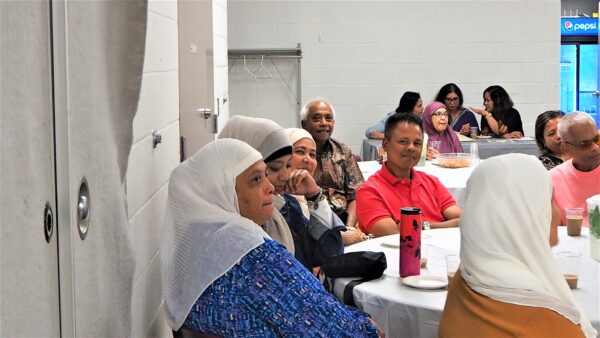The Annual General Meeting of “SLAMAT” – Sri Lanka Malay Association of Toronto (Photos – Thanks to Noor Rahim)

The Ceremony was brought to Ceylon by the Indonesian ancestors of the Sri Lanka Malays, who arrived with the Dutch invading forces in the 18th Century. There were only a few locations at which these were conducted; and were in the City of Colombo. The ceremony was conducted to mark the martyrdom of Imam Hussein Ibn Ali; and conducted on the first month of the Islamic Year know as Muharram.
The ceremony commenced with a flag raising ceremony and the exhibit of the figure of the Hand and the five fingers on an elaborately designed shield along with other significant religious paraphernalia. At the flag ceremony, devotees would bring their flags depicting Islamic symbols in traditional green and white colours to fulfil or make vows. On conclusion, there would be chanting of prayers for ten continuous days. Every evening the shield was donned by an unmarried youth or boy and paraded around the streets to the chant of Prayers; preceded by a retinue of colourful personnel bearing colourful flags and other trappings, accompanied by Drummers and Percussion Players. There was also a display of re-enacting battles in commemoration of the Battle of Karbala, with displays of the Martial Arts called colloquially “China Footing” (Silat). The procession stopped at all major intersections with much incense burning, lighting of fire crackers and chanting of prayers. The procession would return to its Base and the continuance of prayers would culminate at night. This process is continued until the end of the tenth day. The culmination of this festivity and prayers ends with a “Fire-walking” ceremony, with the participation of the Shield Bearers and volunteers that may have made vows to do so. For this purpose a large deep pit is dug and firewood is burned to a glowing ember in which the “walk” took place. It was customary for people attending to throw coins into this pit to make vows or for fulfilled vows. The next day, the monies thrown into the pit are collected as funds to be used at the next year’s Ceremony. “Sponsorships” were never heard of in those days and only the monies collected from the donation “Tills” and volunteer donations were used. All participants in the ceremony and the organizers worked purely on a voluntary basis.
The martyrdom of Imam Hussain Ibn Ali, Grandson of Prophet Muhammed is commemorated, in prayers, during this period and culminates on the tenth day; and is known as “Ashura”. Though it is a Shite Muslim Tradition to commemorate the “Battle of Karbala” during which the Imam was martyred; it is nevertheless followed by many of the other sects of Islam. It is believed he was killed whilst praying and his body was dismembered. The performance of this ceremony was unique to the Malays in Ceylon.
The Malays called the Panja Ceremony “JAUSEN”; and also colloquially called “HASSEN HOSSEN” – which is derived from the chanting of Yaa! Hassen, Yaa! Hossen, by devotees, at and during these religious events.
This ceremony was to meet its demise in the early 1940’s when the Muslim clergy along with the local Muslim politicians including Malay politicians denouncing it as idol worship and was in contravention of the teachings of the Holy Quran. Almost all Malays in Sri Lanka follow the Sunni Sect of Islam.
Amongst the various beliefs in the significance of the “Panja”; the popular belief of the hand symbol was that this represented the dismembered hand/fingers of the Imam. In Canada one will notice that most of the Lebanese owned shops had the symbol of the “Hand” with an “eye” in the middle of it. The significance of the “hand” I was told was to ward off “evil eyes”; and as a symbol of good luck and harmony. Thinking back on the “hand” symbol and the stopping of the procession with chanting of prayers and lighting of fire crackers gives me the belief that this was done to ward “off” evil eyes and evil spirits from the area; in addition to the significance of Muharram and the commemoration of the martyrdom of the Imam.
History has it that this traditional ceremony was imported into West Sumatra by the Indian/Bengali Sepoys (soldiers), brought in by the British, when they occupied Sumatra. This ceremony has now become a Tourist attraction. They commemorate the symbolic collection of all the dismembered body of the Imam and its veneration. The Minangkabau Folks of West Sumatra who commemorate Muharram, particularly in the City of Pariaman call it TABUIK.
The Tabuik Festival is held annually in the city, every 1-10 days of Muharram, to commemorate the Day of Ashura. The festival commemorates the death of the grandsons of Muhammad, Hasan and Hossen. A mythical creature called a Bouraq – a winged horse with a human head – is said to have carried their souls to heaven. In the festival, two effigies of the Bouraq called Tabuik are carried through the city. The Tabuik, named Tabuik Pasa and Tabuik Subarang, are swayed and manually carried in procession, accompanied by tambur music and tasa drums; and in the afternoon, moved to the coast before sunset and are immersed into the sea. Thus ended the festivities.





please visit eLanka Facebook page to view the full set of official photos from the dance –https://www.facebook.com/media/set/?vanity=eLanka.com.au&set=a.6645734038792605&_rdc=1&_rdr







